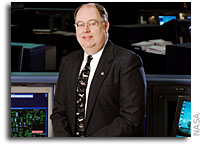Wayne Hale’s NASA Blog – Ponce De Leon

Ponce De Leon is famous in history for trying to find the Fountain of Youth where one sip of the water would not only let you live forever but restore youthful vigor and health. Needless to say, the legend of Ponce De Leon diverges considerably from what we know of the real, historical Ponce De Leon.
For example, it is not really clear exactly where in the modern day state of Florida Ponce De Leon landed or carried out most of his exploration. Navigation was crude in those days, maps were inaccurate, and landmarks are few. So we don’t really know where he was. But in more modern times, various localities have claimed their area was the place and so, about 40 miles north of the Kennedy Space Center, an estuary bordering on Daytona Beach is called Ponce Inlet.
It is exceedingly important for Mission Control to be able to communicate with the shuttle crew throughout the powered flight phase ascending to earth orbit. Onboard navigation can be fooled under certain circumstances and the onboard computers do not have the power or the programming to project ahead for various off nominal situations. So, for example, MCC is prime for abort mode determination. Systems information, too, can be more readily assessed from telemetry to the ground than from onboard displays in many cases, although that has improved as the shuttle cockpit has evolved.
From the early days of space flight, having good tracking and communications stations was vital. In his book “Flight, My Life in Mission Control”, Chris Kraft notes that the creation of a world wide tracking network was one of the great accomplishments of NASA in its early years. Nowadays we use satellites to talk with the crews most of the time and all but a few of the ground tracking stations have been closed down.
The shuttle is a peculiar beast. The radio antennas are arranged around the crew cockpit. Since the shuttle flies a heads down trajectory for much of the ascent phase, the external tank blocks the line of sight between those antennas and the relay satellites up in geosynchonous orbit. After the closure of the Bermuda tracking station, a new maneuver was added to the shuttle ascent trajectory to roll to heads up late in powered flight just so the shuttle antennas would have a good line of sight to the relay satellite. Early flight remains heads down to facilitate a return to launch site abort (RTLS) if that drastic maneuver would ever be required.
The primary means of communication is through the venerable and tremendously busy Merritt Island Launch Area (MILA) tracking site which is very close to the KSC visitor center should you go there. MILA has a number of antennas, and great infrastructure, but there is one tiny problem.
The shuttle lifts off the pad using powdered aluminum. That’s right, the solid rocket boosters use powdered aluminum as a propellant. One of the principle constituents of the SRB exhaust is aluminum oxide. And aluminum oxide is a perfect way to stop radio waves. So from about 20 seconds into the launch when the shuttle points its stern quarter directly at MILA until the solid rocket boosters are separated at two minutes, MILA is helpless to communicate with the crew. No MILA, no relay satellite, what are we to do?
Enter PDL. The Ponce De Leon tracking station is an adjunct to MILA. It is located on the south side of Ponce Inlet just across the estuary from Daytona Beach. On a good day you can hear the NASCAR races. PDL is a sort of minimalist tracking station; one big antenna, one string of transmitters and receivers, and a crew of about four folks. And the only good line of site to the shuttle for a crucial minute and a half of the early ascent.
Sim Sup loves to give the ascent team fits during training. There were times when I believed the training team was being paid based on the number of malfunctions they could introduce in each training run. A lot of those failures were inserted into the simulations in the first two minutes of flight and troubleshooting could not wait. So in simulations we learned to rely on the PDL station.
I’m pleased to say that one of my first visits when I was assigned to KSC was to take a road trip to PDL and tell the folks there how important they are and how much the Flight Director counts on them.
STS-93 was a case in point. During most launches the shuttle performs flawlessly and you might think that all our training was a waste of time. During the early part of STS-93 we had not one, not two, not three, but four inter-related anomalies. Sim sup isn’t supposed to work in real time! It was crucially important that MCC guide the crew through the complexities of that situation. And it had to be voiced up using the PDL station.
A lot of spaceflight is like that. A few folks building and maintaining a function that you might never need. But on the day you need it — your really need it and nothing else will do.
I hear a lot of folks who profess that they can do spaceflight on the cheap. I am sure that some costs can be lowered. But giving up critical capabilities that can save your . . . .spacecraft . . .in an emergency — that is a foolish economy.
Events like STS-93 can make your hair turn gray. Maybe we need to find that fountain that old Ponce was looking for after all!
In closing, I want to thank the NASA employees who are working on the acquisition teams. Thanks to their efforts, we should have new contracts in place by early 2010 and be on our way to consolidating NASA’s IT infrastructure.








